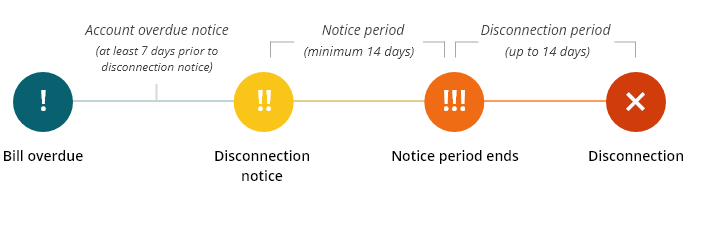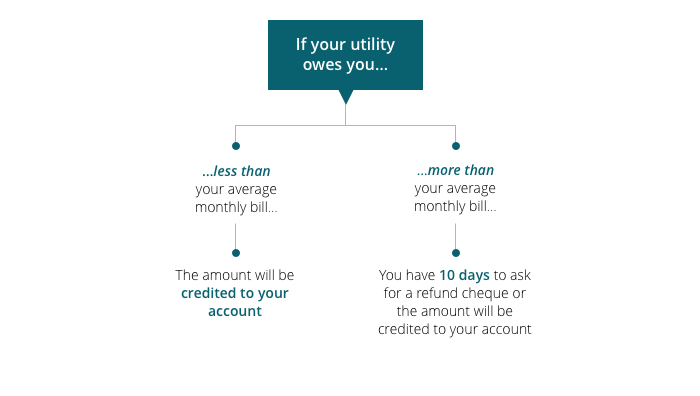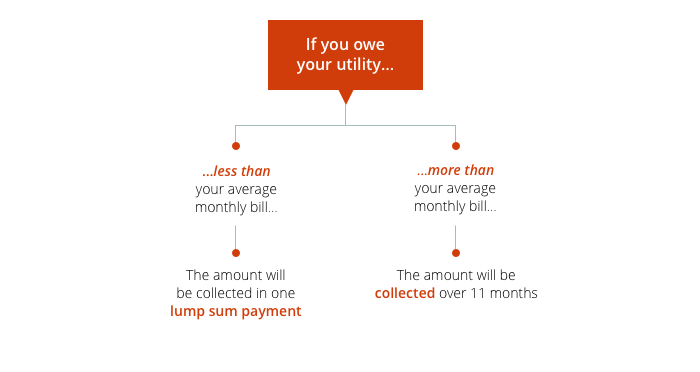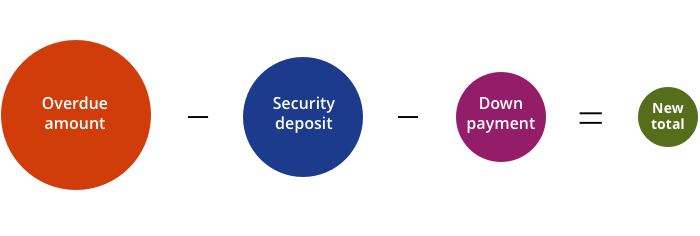There are specific rules governing customer service that all electricity utilities must follow. Here are a few examples of the rules we have made to protect you as a residential or small business electricity consumer:
- You cannot have your electricity supply disconnected for non-payment without having 14 days’ notice.
- Generally, you must be provided with payment options, including an equal monthly payment plan.
- If you are unable to pay your bills, in most cases, the utility must offer you the chance to go on a payment plan.
If you live in a condo or apartment that has its own individual meter and your bill comes from a company other than the local utility, you are a customer of a unit sub-meter provider. Most of our customer service rules for utilities also apply to unit sub-meter providers. Any differences are noted below.
If you are eligible as a low-income customer, you may, in some cases, be exempt from having to pay a security deposit. Disconnection can also be delayed if a LEAP intake agency informs the utility that it is checking to see if you qualify for emergency financial assistance under our low-income energy consumer programs.
Rules for electricity consumers
No matter where you live in the province, you can expect a similar level of service from your electricity utility or unit sub-meter provider. If your electricity utility or unit sub-meter provider isn’t following the rules we establish for customer service, we have the authority, as Ontario’s energy regulator, to make it comply. And, you’re entitled to make a complaint about them to us. If you have a complaint about an energy company we regulate, contact us.
The rules are listed below. Most of our customer service rules for utilities also apply to unit sub-meter providers. Any differences are noted below. We refer to both utilities and unit sub-meter providers together as electricity provider.
Generally, the rules apply to residential and small business customers.
Security deposits
Electricity providers may ask certain customers for a security deposit. If your electricity provider asks you for a deposit, you do not have a choice about paying it. An electricity provider can disconnect your service or refuse to connect you if the deposit is not paid.
Think of security deposits as a kind of protection. They reduce the amount of bad debt your local utility is exposed to. And in doing so, they help maintain a financially viable energy sector, where customers receive a reliable supply of electricity at a reasonable cost.
This chart shows who is required to pay a security deposit.
| New Customers | Existing Customers |
|---|---|
|
|
Note: Electricity providers are required to waive the security deposit requirement for eligible low-income customers upon request.
Deposits are calculated using your recent electricity bills. The maximum deposit amount an electricity provider can ask for is 2.5 times your average monthly bill.
If you do not have a history with the electricity provider, they can use a reasonable estimate - like the average bills from the residence you are moving into - to calculate the deposit. If your electricity usage goes up, the electricity provider can ask for an additional security deposit as long as it does not go over the maximum amount.
Residential customers have at least 6 months to pay the deposit in equal instalments. Small business customers have at least 4 months to pay the deposit in equal instalments.
Can I get my deposit back?
Residential customers with 1 year of good payment history will have their deposits returned. Small business customers with 3 years of good payment history will have their deposits returned.
If you move or close your account with an electricity provider, they have up to 6 weeks to return your deposit, but they also have the right to use the security deposit to offset any other amounts that you owe. They must also pay interest on the deposit, which is calculated at the Bank of Canada’s prime business rate less 2%. Interest is paid once every 12 months if the deposit is retained.
Equal payment plans
Electricity utilities must offer you the option to join what is called an equal monthly payment plan.
However, as a residential customer if you are enrolled with an electricity retailer, or you owe your electricity utility money for unpaid bills, you may not be allowed to join an equal monthly payment plan. Unit sub-meter providers do not have to offer equal payment to their customers.
Utilities must offer equal payment plans to small business customers except those who (1) have a contract with an energy retailer; (2) have less than one year of billing history; (3) are in arrears or their participation in the plan was cancelled for non-payment in the past year; or (4) have unpredictable consumption usage and for whom amounts cannot be estimated with a reasonable degree of accuracy.
How it works:
- Typically, your utility will add up your bills for the last 12 months and divide the total by 12 to get the average. That is the amount they will bill you each month.
- You may sign up to have your payments automatically withdrawn from your bank account.
- Your utility will review your equal monthly payment plan at least once per calendar year to make sure you have not paid too much or too little.
Late payment charges
Late payment penalties are a way to encourage prompt payment of bills. When you pay on time, it reduces additional costs to your utility provider - and that lowers delivery rates for all consumers.
Interest Rate Limits
Ontario utilities can charge customers a late payment penalty of 1.5% per month (effective annual rate of 19.56% per year or 0.04896% per day) - the maximum allowed by the Ontario Energy Board for electricity utilities. It’s a good idea to pay your bill promptly. Unit sub-meter providers are allowed to charge penalties for late payment; the rate is set in their contracts with building management.
For all electricity providers, late payment charges will begin 20 days after your bill is issued. This chart shows how it works:
Billing Terms
| Issue Date | A bill's Issue Date is defined as 3 days after it was printed, if sent by mail. If the bill was emailed, the Issue Date is defined as the date it was sent. |
| Received | A bill payment, if mailed, is considered received by the electricity provider 3 days before the company actually receives it. If paying at a bank or by credit card, the payment is considered received when the financial institution acknowledges it. Occasionally, that will not be the same day it was paid. |
| Due Date | A due date scheduled on a weekend or holiday is considered the next business day. |
Overdue / Arrears Payment Agreement
As a final step before disconnection, your electricity provider must give you the chance to go on a payment plan. This payment plan is known as an Arrears Payment Agreement.
How it works for residential customers:
- If you have a security deposit with your electricity provider, they must use it toward the amount owing.
- The electricity provider will charge you a down payment. The down payment can be as much as 15% of the total amount you owe. You may also have to pay any additional service charges (such as a reconnection charge) on top of that.
- The electricity provider will then calculate the new total you owe.
How much time you have to pay the arrears
| If you owe: | Then your payment plan timeline will be: |
|---|---|
| Less than twice your average monthly bill | At least 5 months |
| More than twice your average monthly bill | At least 10 months |
Getting your power reconnected
For utility customers, if you’ve entered into a payment plan after your power has been disconnected, you can generally expect your utility to reconnect your electricity supply within 2 business days. Unit sub-meter providers do not have a specific time frame for reconnecting their customers.
Don’t miss payments
Once you begin making monthly payments, you must still pay your regular electricity bills. If you miss more than one payment on either the arrears payment agreement or your bills, the electricity provider can cancel the agreement. They can then take steps to disconnect you.
See if you qualify
- If you’ve already been on an arrears payment agreement for unpaid bills in the past 2 years, your electricity provider may refuse to allow another one. They may move to disconnect your service if you have unpaid bills.
- If an arrears payment agreement is cancelled early due to non-payment, the electricity provider may require that you wait 1 year before entering into another one.
Small business customers who are facing disconnection for non-payment must be offered an Arrears Payment Agreement. The terms and conditions of these arrangements are not set by the OEB, but they must be reasonable.
Disconnection
If you fail to pay your electricity bill, your electricity provider can disconnect your supply. They can also disconnect power if you fail to pay a required security deposit. If you have paid a security deposit, it will be applied to the amount you owe before your electricity supply is disconnected. Electricity utilities cannot disconnect residential customers for non-payment in the winter months, between November 15 and April 30. The winter disconnection ban applies to electricity utilities only – unit sub-meter providers may still disconnect customers for non-payment during the winter months. See next section for details.
Before disconnecting you, the electricity provider must:
- Give you an account overdue notice (by telephone, mail, email, other) at least 7 days before issuing a notice of disconnection.
- Give you at least 14 days’ notice. If disconnection of electricity poses a risk of significant adverse effects on your physical health, or that of anyone who lives in your home, and you have documentation from your doctor, the provider must give you at least 60 days’ notice before disconnecting you.
- Once the notice period ends, your service can be disconnected at any point during the next 14 days.
- If you are a residential customer, your electricity provider must make a reasonable effort to contact you one last time at least 48 hours before your actual disconnection date. They can do this in person or by phone. You should make sure the electricity provider has up-to-date contact information on file. You may also be able to pay off your outstanding balance when a worker arrives to cut off your power. The utility must have staff available to accept your payment at that time. They must also accept credit cards. If the company chooses, it can accept other forms of payment too. The requirement to accept payment on the day of disconnection does not apply to unit sub-meter providers.
- The electricity provider does not have to inform you that the disconnection is about to happen. Do not wait for them to show up.
- If a social service agency informs your electricity provider that it is checking to see if you qualify for emergency financial assistance under our low-income energy consumer programs, the electricity provider will delay disconnecting your service for up to 21 days.
This chart shows the process for disconnections.

Avoiding disconnection
To avoid disconnection, it is important to contact your electricity provider as soon as you receive that notice. Do not delay.
The quickest way to keep your electricity connected is by paying your outstanding balance.
If you cannot pay the amount you owe, you have the option of setting up a payment plan (an Arrears Payment Agreement) that will allow you to repay your debt over a period of time. It does not excuse you from paying the amount owed or from paying your new bill.
Your home cannot be disconnected during the winter
Licensed electricity utilities are banned from disconnecting residential customers for non-payment during the winter every year, from November 15 to April 30. Also, homes that are already disconnected for non-payment and are occupied must be reconnected by December 1 without charge. The Ontario Energy Board has also banned the use of load control devices on homes during the same period and requires utilities to remove existing devices on homes by December 1, again without charge (unless the customer asks for such a device).
You are encouraged to pay your bill during the ban period as the utility may continue to charge late payment fees on past due amounts on your bill. Customers who are in arrears may face disconnection when the disconnection ban is lifted. Special programs are available to help low-income consumers.
Reconnection fee
For utility customers, the utility will generally charge you a fee to reconnect service. If you are unable to pay the charge, the utility must offer you a reasonable payment arrangement following the reconnection.
Low-income customers do not have to pay this charge.
For utility customers, once you’ve paid your bill in full or entered into a payment agreement, you should generally expect the utility to reconnect your service within 2 business days. Unit sub-meter providers do not have a specific time frame for reconnecting their customers.



